Amazon Business Models: How to Choose the Right One?
Download Amazon Seller Guide
This guide will help you get started, understand the basics of Amazon selling, and explain in simple words how it all works.

Amazon business models offer sellers a world of opportunities – but picking the wrong one can stall your growth before you even get started. Whether you're just launching your first product or scaling an existing store, choosing the right model is key to your success.
From wholesale and online arbitrage to dropshipping and private label, each path has its own risks, rewards, and realities.
In this post, we will break down everything you need to know to find the model that fits your goals, budget, and experience level. Let’s help you build smarter, faster, and stronger on Amazon.
What Are Amazon Business Models?
.avif)
Amazon business models are the different strategic patterns sellers use to make money on Amazon. Each model defines how you source products, manage inventory, set prices, and interact with customers. In short, your business model shapes how you operate and what steps you’ll need to succeed.
Having a clear business model is crucial. It provides a structured approach to building your business, clarifies the daily activities you’ll focus on, and helps you set realistic expectations for investment, workload, and growth. Without a solid business model, it’s easy to waste time, overspend, or pursue the wrong opportunities for your goals and resources.
Main types of amazon business models
There are several popular Amazon business models, each offering different levels of control, investment, scalability, and risk. Here’s a quick overview.
Private label
You create and sell your own branded products, typically by customizing products manufactured by suppliers. Private label gives you full control over branding, pricing, and marketing – but it also requires higher upfront investment and a longer timeline to profitability.
Wholesale
You buy branded products in bulk directly from authorized brands or distributors and resell them on Amazon. Wholesale provides more predictability and easier scaling, but securing supplier accounts and dealing with competition can be challenging.
Online arbitrage
Similar to retail arbitrage, but sourcing is done entirely online. It offers convenience and a broader reach but comes with fierce competition and time-consuming research.
Dropshipping
You list products on Amazon without holding inventory. When a customer buys, your supplier ships the product directly to them. Dropshipping has the lowest startup costs but also carries risks related to quality control, Amazon’s strict policy compliance, and profit margin instability.
Retail arbitrage
You purchase discounted products from local brick-and-mortar stores and resell them for profit on Amazon. Retail arbitrage is one of the easiest ways to start, but it’s labor-intensive and difficult to scale.
Related: Amazon Retail Arbitrage 2025 Guide
Amazon Online Arbitrage: How to Make Money
Amazon Wholesale: How to Sell Wholesale on Amazon in 2025
Amazon Business Models: Summary
Amazon offers several business models to suit different goals, budgets, and experience levels. In this section, we’ll break down each model to help you choose the one that fits your Amazon selling journey best.
Wholesale: selling established brands for profit
.avif)
Wholesale is an Amazon business model where you purchase branded products in bulk directly from manufacturers, brands, or authorized distributors at discounted rates – and then resell them individually on Amazon for a profit. Unlike private label, you’re selling existing, trusted products that already have customer demand and proven sales records. This makes wholesale one of the most straightforward and predictable ways to succeed on Amazon.
Example
Imagine you buy 500 units of a well-known kitchen gadget brand at $10 per unit from an authorized distributor. You then resell each unit on Amazon for $25. After Amazon fees and shipping costs, you net a healthy profit per item – without needing to create a brand or listings from scratch.
How wholesale works on Amazon
Here’s a step-by-step overview of the wholesale process.
Step 1. Obtain a reseller's permit
Register for a reseller’s permit to buy goods tax-free from suppliers. This is a required step for working with most legitimate wholesale vendors.
Step 2. Choose your product niche
Focus on a product category that has strong demand, manageable competition, and aligns with your interests or expertise.
Step 3. Find reliable suppliers
Identify brands or authorized distributors offering products you want to resell. Use tools like Seller Assistant's Brand Analyzer to streamline your supplier research.

Step 4. Verify supplier legitimacy
Before partnering, verify suppliers by checking references, online reviews, LinkedIn profiles, and platforms like Whois or ScamAdviser.
Step 5. Open a wholesale account
Reach out to suppliers and submit a wholesale application with your business information and reseller’s permit.
Step 6. Request product catalogs and price lists
Once approved, ask for wholesale price lists and available inventory catalogs to review potential products.
Step 7. Analyze products for profitability
Upload the supplier's price list into Seller Assistant's Price List Analyzer. Filter for profitable products, check your selling eligibility, and flag restricted or risky items.
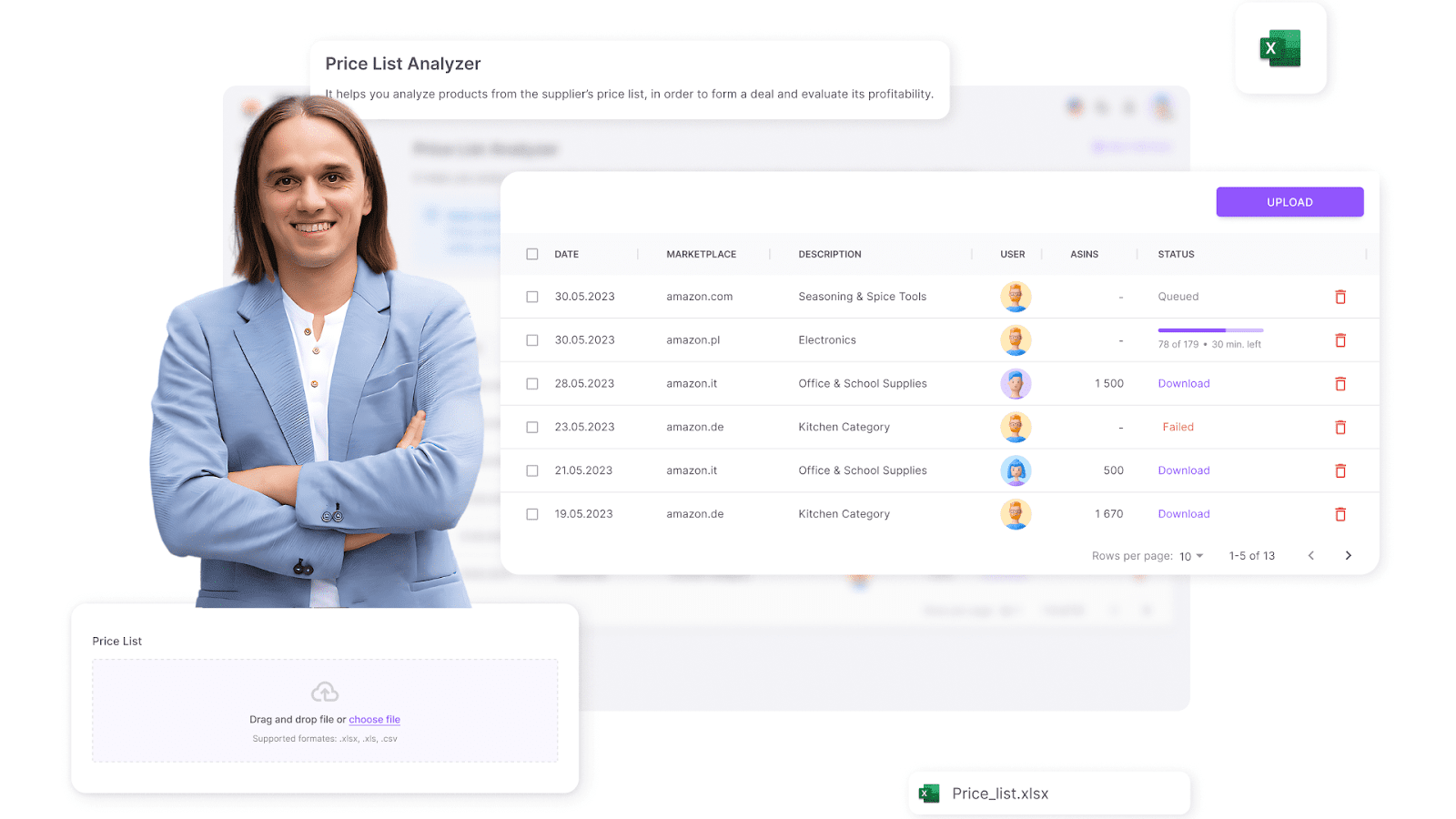
Step 8. Negotiate order terms
Discuss order volume, payment terms, shipping arrangements, and potential future discounts with your supplier.
Step 9. Purchase your first inventory
Place your initial order – estimate how many products you can sell monthly by looking at the sales estimates in Seller Assistant's Price List Analyzer.
Step 10. List your products on Amazon
Add your offer to Amazon listings that correspond to your ASIN. If your product already exists on Amazon, you don’t need to create a new product page.
Step 11. Prepare and ship products
Decide whether to use Fulfillment by Amazon (FBA) or handle orders yourself via Fulfillment by Merchant (FBM). Prep products according to Amazon’s guidelines if using FBA.
Step 12. Sell, monitor, and reorder
Track sales, monitor profitability, and reinvest earnings into restocking your inventory for steady growth.
Note. Seller Assistant is a comprehensive product-sourcing software that helps Amazon sellers quickly find high-profit deals. It combines three extensions: Seller Assistant Browser Extension, and IP-Alert Chrome Extension by Seller Assistant, and VPN by Seller Assistant, Amazon seller tools: Price List Analyzer, Brand Analyzer, Seller Spy, Bulk Restrictions Checker, and API integrations, and features: Storefront Widget, Side Panel View, FBM&FBA Profit Calculator, Quick View, ASIN Grabber, UPC/EAN to ASIN converter, Stock Checker, IP Alert, and Restrictions Checker.
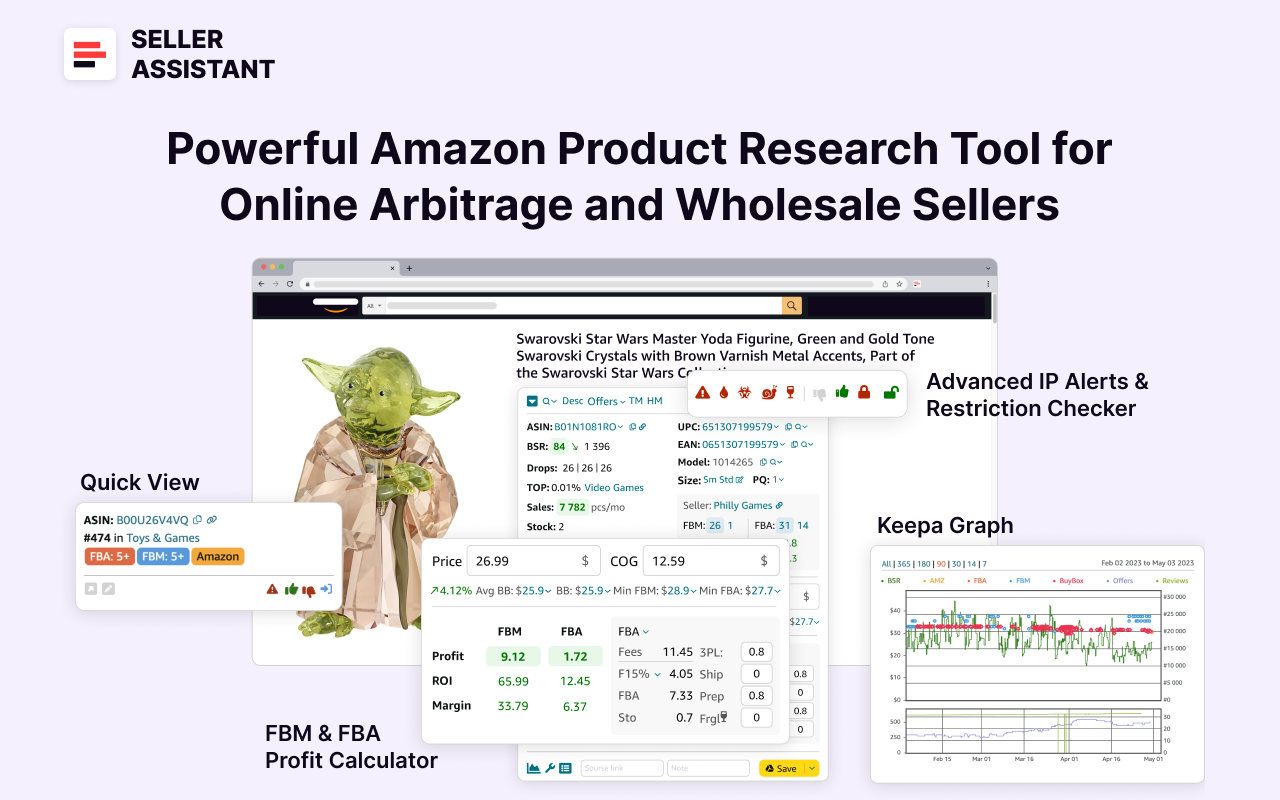
It offers a robust toolkit of over 20 features built to streamline every part of the sourcing process – from bulk scanning wholesale supplier sheets for high-margin leads to deep product research and advanced brand and competitor analysis. By using this FBA and FBMproduct sourcing software, you can easily identify products that have the potential to be sold well on Amazon.
Three key insights for wholesale sellers
Capital is key for big profits
Wholesale is profitable, but requires a few thousand dollars upfront to purchase inventory at competitive prices.
Strong supplier relationships are essential
Long-term success relies heavily on building trustworthy partnerships with brands and distributors.
Thorough product research protects you
Smart sellers use tools like Price List Analyzer to avoid low-demand products and over-competitive listings.
Pros of the wholesale model
%20(1).avif)
Fast launch timeline
You can start selling within about six weeks once suppliers and inventory are secured.
High-profit potential
Buying in bulk at lower unit costs often leads to profit margins of 30% or more.
Predictable revenue and cash flow
Reselling proven products with existing demand makes income forecasting much easier.
Easily scalable
Growth simply means ordering more inventory – you don’t need to constantly change strategies.
No marketing or listing creation needed
Since you're listing against existing ASINs, you skip the need for branding, creating listings and keyword optimization, PPC expenses, or external marketing.
Cons of the wholesale model
%20(1).avif)
Significant upfront investment required
Most suppliers expect minimum orders ranging from $1,000 to $5,000 or more.
Challenging supplier access
Brands often favor established sellers, meaning you need a professional presence to get approved.
Listing competition is inevitable
You’ll often share listings with multiple sellers, competing for the Buy Box and price positioning.
Time-consuming research and negotiations
Sourcing profitable deals and closing agreements takes research, patience, and outreach.
High-risk if you pick the wrong product
Wholesale mistakes can be costly, tying up thousands of dollars in slow-moving or unsellable inventory.
Startup cost for wholesale
Estimated investment: $2,000–$5,000+, depending on product category, supplier requirements, and initial order volume.
Online arbitrage: reselling discounted online deals for profit
.avif)
Online arbitrage is an Amazon business model where sellers purchase discounted products from online retail stores and resell them on Amazon for a profit. This strategy relies on spotting price differences between retail websites and Amazon listings – allowing sellers to "buy low and sell high" after accounting for Amazon fees and shipping costs.
Example
Imagine you find a popular board game on a major retailer’s website selling for $15, while it’s listed on Amazon for $35. You purchase multiple units, list them on Amazon, and after fees and shipping, you earn a healthy margin on each sale – without ever leaving your house.
How online arbitrage works on Amazon
Here’s a detailed step-by-step look at the online arbitrage process.
Step 1. Create an Amazon seller account
Register for either an Individual or Professional selling plan to gain access to Amazon Seller Central and start managing your sales.
Step 2. Search for profitable deals
Manually browse retail websites or use sourcing tools like Seller Assistant's tools to discover profitable leads: Price List Analyzer to automate parsed supplier data research, Brand Analyzer to select profitable brands, Seller Spy and Storefront Widget to analyze competition and sell what they sell successfully, Side Panel View to research deals on the supplier websites side-by-side, and Quick View to do express analysis and get rid of waste leads.
Step 3. Conduct detailed product research
Check each product’s eligibility, profitability, sales history, and risk factors (such as IP complaints, hazmat warnings, or other restrictions) using Seller Assistant Extension.

Step 4. Decide how much inventory to purchase
Estimate sales velocity and assess your budget before buying. Start with small quantities to minimize risks and avoid tying up too much capital.
Step 5. Buy products from online retailers
Leverage discounts, cashback offers, coupons, and rewards programs to lower your product costs and boost your profit margins.
Step 6. List your products on Amazon
Either add your offer to an existing listing or create a new one if the product does not yet exist in Amazon’s catalog.
Step 7. Select a fulfillment method
Choose between Fulfillment by Amazon (FBA) for hands-off logistics or Fulfillment by Merchant (FBM) if you prefer to handle shipping yourself.
Step 8. Set competitive pricing
Use dynamic repricing tools to stay competitive, win the Buy Box, and maximize profitability.
Step 9. Sell, monitor, and scale
Track your sales, manage inventory levels, and use automation tools to streamline sourcing and expand your product catalog over time.
Three key insights for online arbitrage sellers
Winning product selection is critical
Focus on products with strong demand, manageable competition, and no selling restrictions to maximize your chances of success.
Product research takes time but pays off
Finding reliable, profitable deals requires consistent effort – but tools like Seller Assistant can dramatically speed up and simplify the research process.
Checking for risks is essential
Always verify if products are eligible for sale and free from hidden risks like IP complaints, hazmat classification, or fragile shipment issues using Seller Assistant’s IP Alert and Alerts and Flags features.

Pros of the online arbitrage model
.avif)
Low startup costs
You can begin online arbitrage with as little as $500, without needing to invest in large inventories or supplier relationships.
Easy to launch
Setting up an Amazon account and sourcing your first profitable products can often be completed within 2–3 months.
Work from anywhere
Because sourcing is entirely online, you can manage your business from home – or anywhere with an internet connection.
Access to a broader inventory pool
Unlike retail arbitrage, you’re not limited to local stores; you can tap into national and even international retailers for better sourcing opportunities.
Flexible and scalable
Start small and reinvest profits to grow gradually. Sourcing and pricing processes can later be automated with tools like Seller Assistant.
Cons of the online arbitrage model
.avif)
High competition for deals
Many sellers target the same products, leading to more pricing pressure and potentially lower margins.
Time-consuming product research
Identifying compliant, profitable products still requires daily effort, even when using advanced tools.
Unstable profit margins
Price wars and fluctuating competition can cause profit margins to vary dramatically month-to-month.
Product restrictions and limitations
Some brands or categories require Amazon approval. Failing to verify restrictions with Seller Assistant’s Restriction Checker can leave you stuck with unsellable inventory.
Risk of IP complaints
Unauthorized selling of branded items can trigger intellectual property complaints, leading to listing takedowns or account warnings. Seller Assistant’s IP Alert feature helps you avoid such products.
Startup cost for online arbitrage
Estimated investment: around $500+, depending on how many products you start with and the intensity of your sourcing efforts.
Private label: building your own brand on Amazon
Private label is an Amazon business model where you create your own branded products and sell them exclusively under your brand name. Instead of reselling existing items, you work with manufacturers to develop customized products, allowing you full control over pricing, marketing, product design, and long-term business growth.
Example
Suppose you notice that bamboo kitchen organizers are trending. You find a supplier on Alibaba who can produce a custom-designed organizer featuring your logo and packaging. You register your brand, create an Amazon listing, and market your product under your own name – building brand loyalty and enjoying higher margins.
How private label works on Amazon

Here’s a detailed step-by-step breakdown of the private label process.
Step 1. Identify a product niche
Use product research tools to find trending items with high demand and relatively low competition. Focus on products you can improve or differentiate.
Step 2. Find a manufacturer
Search for suppliers on platforms like Alibaba, 1688, or Global Sources who can produce and customize your products according to your branding needs.
Step 3. Customize your product
Request changes such as logo placement, packaging upgrades, or slight design modifications to make your product stand out in the market.
Step 4. Register your brand with Amazon
Enroll in Amazon Brand Registry to protect your intellectual property and unlock access to enhanced marketing tools like A+ Content and Sponsored Brand Ads.
Step 5. Order your initial inventory
Place your first bulk order (usually 300–1000 units) and ship it either to Amazon FBA warehouses or your own fulfillment center.
Step 6. Create a product listing
Build a new, SEO-optimized product page with strong titles, bullet points, images, and enhanced content to increase visibility and conversions.
Step 7. Launch and promote your product
Run Amazon PPC campaigns, use social media marketing, influencer collaborations, and promotional offers to generate early sales and build momentum.
Three key insights for private label sellers
You're building a real brand
Private label focuses on developing a brand customers recognize and trust, offering the potential for long-term sales and loyalty.
Upfront investment and patience are required
Significant startup capital is necessary, and it may take several months of product development and marketing before you reach profitability.
Product differentiation is critical
Standing out in a crowded marketplace depends on offering unique features, solving a specific customer pain point, or branding your product creatively.
Pros of the private label model
.avif)
Full brand ownership
You control your listings, pricing, customer messaging, and business reputation without competing directly on someone else’s listings.
Higher profit margins
Custom products with strong branding typically command 40–60%+ profit margins, much higher than reselling models.
Scalable and sellable business asset
You’re building a brand that can be expanded across multiple products – or even sold as a profitable business later on.
Access to exclusive Amazon tools
Brand Registry participants can access A+ Content, Sponsored Brands ads, Amazon Posts, and detailed brand analytics.
Control over the customer experience
You dictate product quality, packaging, branding, and customer service standards, building trust and repeat purchases over time.
Cons of the private label model
.avif)
High startup costs
Launching a private label brand typically requires an upfront investment of $2,000–$5,000 or more, covering product development, inventory, and marketing.
Longer time to profitability
From idea validation to market launch and brand building, private label businesses often take months to become cash-flow positive.
Requires deep market research
Success hinges on thorough product validation and competitive analysis. Poor market research can lead to costly mistakes.
Ad spend is necessary
Without investing in Amazon PPC and off-Amazon marketing strategies, even excellent products may struggle to gain visibility.
Inventory risk and cash flow challenges
Because you’re purchasing inventory upfront in bulk, slow sales can tie up significant capital and cause storage or liquidation problems.
Startup cost for private label
Estimated investment: $2,000–$5,000+, covering product sourcing, branding, packaging, listing creation, and initial marketing efforts.
Dropshipping: selling without holding inventory
%20(1).avif)
Dropshipping is an Amazon business model where you list products for sale without ever handling or storing them yourself. When a customer places an order, your supplier fulfills it – either by shipping directly to the customer or by sending it to a prep center first to meet Amazon’s compliance requirements.
Example:
Suppose you list a popular gadget on Amazon for $40, sourced from a supplier charging you $25. Once a customer orders, your supplier ships the item directly to the buyer (or through a prep center), and you keep the profit margin without ever touching the product.
How dropshipping works on Amazon
Here’s a detailed step-by-step overview of the dropshipping process.
Step 1. Open an Amazon seller account
Register for either an Individual or Professional plan, based on how many units you plan to sell per month.
Step 2. Find a reliable supplier
Choose a supplier who can offer competitive prices, maintain fast shipping times, and meet Amazon’s strict fulfillment and packaging standards.
Step 3. Select your products
Use sourcing tools like Seller Assistant Extension to evaluate product demand, competition, profit margins, and selling eligibility before listing.
Step 4. List the product on Amazon
Create a compliant listing on Amazon by adding the product’s ASIN or creating a new listing if necessary.
Step 5. Receive a customer order
Once a customer places an order, Amazon notifies you through Seller Central.
Step 6. Forward the order details to the supplier
Send the product and customer information to your supplier for fulfillment.
Step 7. Supplier ships the order
Suppliers can either ship directly to the customer with compliant packaging or first send the product to a prep center for repackaging.
Step 8. Repackage at a prep center (optional)
Using a prep center ensures that shipments meet Amazon’s strict rules regarding branding, invoices, and seller information.
Step 9. Customer receives the product
The customer receives the item, and you earn the profit margin between your Amazon selling price and your supplier’s wholesale cost.
Three key insights for dropshipping sellers
Compliance with Amazon policies is non-negotiable
Amazon requires that you are listed as the seller of record, with no third-party logos or branding on the packaging or invoices.
Supplier reliability determines success
Since you don’t physically inspect or ship the product yourself, having trustworthy suppliers who deliver on time and maintain quality is essential.
IP complaints are a major risk
Selling branded products without authorization can trigger intellectual property complaints. Use Seller Assistant’s IP Alert tool to check product risks before listing.
Pros of the dropshipping model
.avif)
Low upfront costs
You don’t need to buy inventory in advance, making it ideal for sellers with limited starting capital.
No inventory management
Suppliers handle storage, picking, packing, and shipping, freeing you to focus on research and customer communication.
No pressure to liquidate inventory
Since you only pay for products after making a sale, you avoid the risks of unsold stock and clearance pricing.
Work-from-anywhere flexibility
Because sourcing and management are entirely online, you can run your dropshipping business from anywhere.
Strategic pricing opportunities
Dropshippers can set slightly higher prices than competitors and wait for others to sell out, profiting from temporary market gaps.
Cons of the dropshipping model
.avif)
Limited control over product quality and shipping
You must rely completely on your suppliers to maintain product standards and timely deliveries, which can impact customer satisfaction.
Strict Amazon policy enforcement
Amazon tightly regulates dropshipping operations; failure to comply with policies can quickly lead to account suspension.
Selling restrictions and eligibility
Always confirm you are authorized to sell specific products or brands to avoid restricted product issues.
High risk of IP complaints
Unauthorized sales of branded goods can result in takedowns, legal notices, and account health problems. Always pre-check for IP complaints.
Customer service complications
You are responsible for customer support issues, even if problems arise from suppliers you do not control, making resolutions slower and more difficult.
Startup cost for dropshipping
Estimated investment: $100–$500+, covering Amazon account fees, sourcing tools like Seller Assistant Extension, and optional prep center services. No upfront inventory investment is required.
Retail arbitrage: reselling discounted retail finds for profit
%20(1).avif)
Retail arbitrage is an Amazon business model where you buy discounted products from physical retail stores like Walmart, Target, or TJ Maxx, and resell them on Amazon for a profit. You make money by spotting price differences – buying low in-store and selling higher on Amazon.
Example
You find a popular toy on clearance at a local Walmart for $10, and it’s currently selling on Amazon for $30. After factoring in Amazon fees and shipping costs, you can still make a solid profit per unit with minimal upfront investment.
How retail arbitrage works on Amazon

Here’s a step-by-step breakdown of the retail arbitrage process.
Step 1. Set up your Amazon seller account
Choose between an Individual or Professional plan, depending on your sales volume, and complete the registration to access Amazon Seller Central.
Step 2. Install a barcode scanning app
Download the Amazon Seller App or other scanning tools to compare in-store product prices against Amazon listings in real time.
Step 3. Visit retail stores
Target clearance events, closeouts, and liquidation sales at major retailers to find deeply discounted, resellable products.
Step 4. Check product listings on Amazon
Ensure the item matches an existing Amazon listing exactly. Analyze profitability, sales rank, eligibility, and potential risks before purchasing.
Step 5. Purchase your inventory
Start with small test purchases or buy more if the product shows strong sales velocity and profit margins.
Step 6. List your products on Amazon
Add your offer to the correct existing ASIN in Seller Central, entering details like pricing and condition.
Step 7. Choose a fulfillment method
Select Fulfillment by Amazon (FBA) for hands-off logistics, or Fulfillment by Merchant (FBM) if you prefer to handle shipping yourself.
Step 8. Restock your inventory manually
After selling through your items, return to stores to hunt for new deals – keeping in mind that discounted stock may not always be replenishable.
Three key insights for retail arbitrage sellers
Real-time product research is crucial
Always scan products on-site with apps to verify current profitability – buying without research leads to risky inventory.
Expect a hands-on, time-consuming process
Retail arbitrage demands regular in-store visits, scanning hundreds of products to find a handful of profitable opportunities.
Restocking is unpredictable
Clearance and sale items are often limited-time opportunities, requiring ongoing sourcing trips to maintain inventory.
Pros of the retail arbitrage model
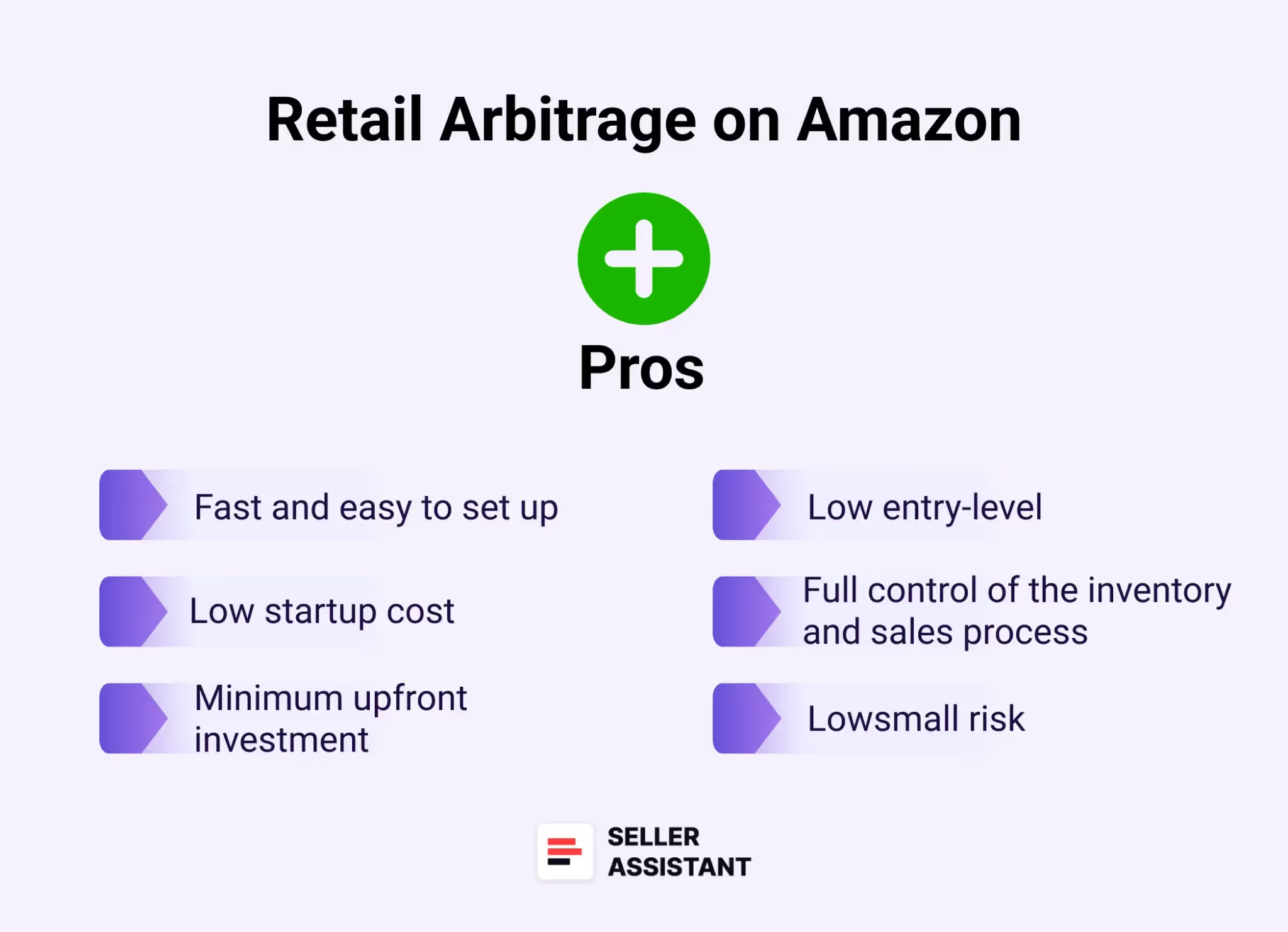
Quick and easy to set up
Getting started is fast – you only need an Amazon account, a smartphone, and some basic sourcing knowledge.
Low startup cost
You can launch your business with around $500 by picking up discounted items locally.
No need for advanced skills
Retail arbitrage is beginner-friendly and doesn’t require technical knowledge, making it accessible to almost anyone.
Low risk with a small investment
Buying discounted, in-demand products reduces the likelihood of being stuck with unsellable inventory.
Fast profit turnaround
If you find good deals, your products can start selling within days after being listed.
Cons of the retail arbitrage model
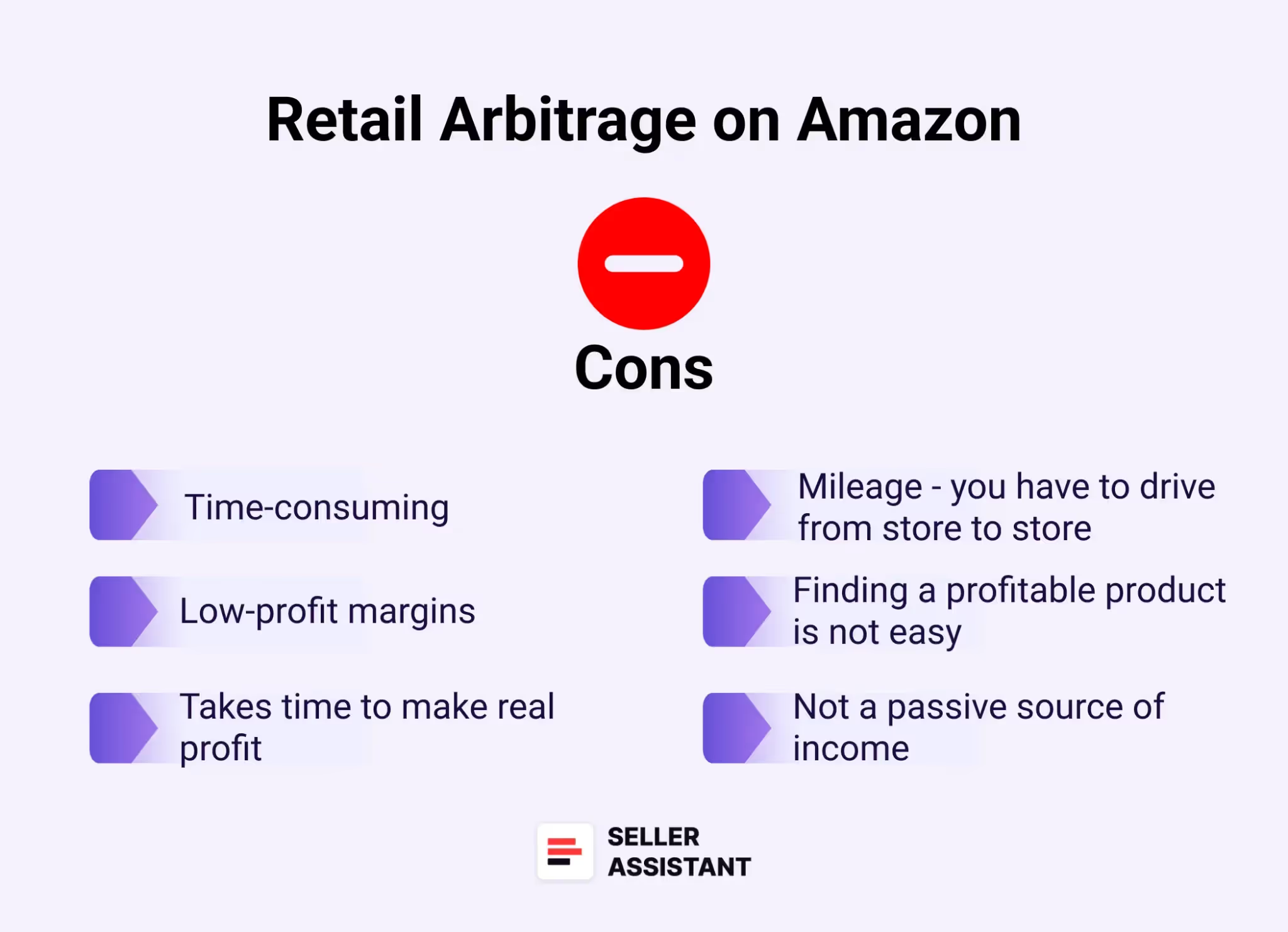
Time-intensive sourcing
Visiting multiple stores and scanning dozens (or hundreds) of products can be tiring and time-consuming.
Manual restocking required
You'll need to continually return to stores to replenish inventory – there's no automatic reorder option.
Scaling is difficult
Growth is limited because you can only sell what you physically find and buy, making it hard to scale quickly.
Inconsistent deal availability
Finding profitable products depends heavily on seasonal sales, luck, and market fluctuations.
Hard to balance with a full-time job
The time demands of sourcing and listing products make retail arbitrage challenging to manage alongside another career.
Startup cost for retail arbitrage
Estimated investment: around $500+, primarily for purchasing your initial inventory and covering Amazon selling fees.
Which Business Model Is Most Popular?
Private label dominates because it offers long-term growth and brand ownership, while wholesale and arbitrage models are favored by sellers looking for quicker wins and lower initial risks. Dropshipping, despite its ease of entry, remains less common due to compliance challenges and lower profit margins.
According to Jungle Scout’s recent research, here’s the breakdown of Amazon sellers across the different models.
Popularity of Amazon business models
.avif)
Private label: 54% popularity
Reasons for popularity
- Brand ownership
Sellers control their brand identity and messaging, fostering customer loyalty.
- Higher profit margins
Lower competition because other sellers can’t resell your brand and potential to set their own prices.
- Product differentiation
Can customize existing products or offer unique features.
Challenges
Require essential upfront investment, product development, and manufacturing, extensive product research, and ongoing marketing.
Wholesale: 26% popularity
Reasons for popularity
- Higher profit margins
Purchase goods in bulk for a lower price per unit and resell them at a higher price which makes increased profits.
- Established brands and demand
Leverage existing brand recognition.
- Scalability
Can quickly scale business with bulk products and higher profits.
Challenges
Require big upfront investment, finding a supplier can be challenging, must do in-depth product research to avoid money loss. However, wholesale price list scanners like Seller Assistant's Price List Analyzer can automate selecting pigh-profit deals on your supplier spreadsheets.
Retail arbitrage: 25% popularity
Reasons for popularity
- Low initial investment
Can start with minimal capital by finding deals.
- Variety of products
Can source discounted items from offline clearance or liquidation stores.
- Simple model
Easy to understand and implement
Challenges
Requires time, effort, and attending physical stores for product sourcing. Volatile profits depend on finding good deals. Highly competitive market with slim margins.
Online arbitrage: 24% popularity
Reasons for popularity
- Fast and easy setup
Can be launched within 2-3 months and you don't need a lot of upfront investment.
- Wide product selection
Access to a vast online inventory. Can find deals on any online marketplace or retailer.
- Helpful tools available
Can use seller tools like Seller Assistant to simplify product sourcing and make it more efficient.
Challenges
Product sourcing is time-consuming. Requires knowledge of online platforms and deal-finding tools. Competition can be fierce, and prices can change quickly.
Dropshipping: 17% popularity
Reasons for popularity
- Low barrier to entry
Quick and easy to start. Requires minimal capital upfront investment compared to other models.
- Hands-off inventory
No need to deal with the inventory. The supplier handles storage and shipping.
- Flexibility
You can work from anywhere with an internet connection and set your own hours.
Challenges
Amazon’s strict dropshipping policies. Lower profit margins due to competition and Amazon fees. Limited control over product quality and shipping times. Reliant on reliable suppliers.
How to Choose the Right Business Model?
When it comes to Amazon seller business models, it's not a one-size-fits-all solution. Choosing the right business model depends on your resources, sales experience, and product type. Below you can find some tips to help you select the goals, and risk tolerance.
5 Tips to choose a business model

Tip 1. Start small and test
Start selling with one of the business models that are easy to set up and doesn’t require high upfront investment. That will help learn to sell on Amazon without much risk. Dropshipping or online arbitrage are good options if you want to start selling on Amazon.
Tip 2. Consider your budget
Look at the startup costs associated with each model. Private label and wholesale models require more upfront capital than online arbitrage, retail arbitrage, and dropshipping models.
Tip 3. Assess your product knowledge
Estimate your product research skills. While online arbitrage and dropshipping require in-depth product research, you can use product sourcing tools like Seller Assistant that can essentially simplify this task. The same type of tools can be used to validate wholesale products. On the other hand, with the private label, you need to do extensive market analysis and understand the product manufacturing process, branding, and marketing.
Tip 4. Evaluate your time commitment
Consider the amount of time you are willing to commit to your Amazon sales. While online arbitrage and dropshipping can be a part-time or full-time business, retail arbitrage and private label are very time-consuming business models. Wholesale will take time when you launch it, but it may occupy less time when it’s already set up.
Tip 5. Don’t stick to one model
Choosing the right business model is an ongoing process. As you gain experience and scale your business, you can adapt your business model type to your new needs and goals. For example, many successful Amazon sellers have grown their online arbitrage business to wholesale.
Can You Use Multiple Business Models?
Many sellers use more than one business model in their Amazon sales. That allows applying different approaches to sell different products, test, and scale businesses. Some combinations of business models to consider are below.
Wholesale + online arbitrage
While typically selling in bulk, wholesale sellers can sell some high-profit products in smaller quantities with online arbitrage. That can be trendy or seasonal items. Wholesale sellers can also test product sales by online arbitrage to check the demand.
Online arbitrage + wholesale
Successful online arbitrage sellers often grow their business. That way, they scale it to wholesale because they begin selling in bulk. However, some of their products are still sold with online arbitrage.
Dropshipping + wholesale
While many think that dropshipping is unable to generate high income, some dropshippers manage to essentially grow their business. Similarly to online arbitrage sellers in the example above, they combine big-volume sales with their dropshipping business.
Retail arbitrage + online arbitrage
Some sellers look for discounted products to sell on Amazon both in brick-and-mortar stores and online. That way, they combine retail and online arbitrage.
How to Find Products for Reselling Business Models
Sourcing profitable products and reliable suppliers for Amazon reselling can feel overwhelming and time-consuming. To simplify the process and uncover high-margin opportunities, many sellers rely on specialized tools like Seller Assistant. Below are four effective methods that can help you source products more efficiently and grow your Amazon business.
Method 1. Bulk wholesale list analysis
What it is
Bulk wholesale list analysis involves reviewing large supplier catalogs to find profitable products for resale. It’s an essential method for wholesale and online arbitrage sellers who work with high volumes of ASINs.
What it achieves
The goal is to quickly filter bulk product data, identify high-margin, low-risk items, and dramatically reduce the time and effort needed for manual evaluation.
How it works
Using Seller Assistant's Price List Analyzer, you can upload a wholesale price list and have it automatically match products to Amazon listings. The tool calculates profitability, flags risks like excessive competition or restricted products, and allows you to apply filters to isolate the most promising leads.

How to research effectively
- Sales performance
Check the product’s Best Sellers Rank (BSR) to ensure there’s strong, consistent demand.
- Competition level
Avoid listings where there are more than 15 sellers or where Amazon dominates the sales.
- Buy Box chances
See who currently holds the Buy Box and evaluate your chances of competing.
- Pricing and profitability
Review ROI, margin percentages, and breakeven points to confirm financial viability.
- Restrictions
Detect any IP risks or gated products to prevent selling issues.
Who it’s good for
- Wholesale sellers managing large spreadsheets or extensive product lists.
- Online arbitrage sellers and dropshippers scraping bulk data from supplier websites.
Method 2. Smart brand sourcing
What it is
Smart brand sourcing uses digital tools to identify profitable, reseller-friendly brands to partner with. This method is especially helpful for sellers aiming to build lasting supplier relationships and needing deep insights into brand performance.
What it achieves
The main purpose is to find brands with high earning potential, low competition, and compliant products that fit Amazon’s policies. Ideally, these brands have broad product ranges, strong customer satisfaction, and minimal direct competition from Amazon itself.
How it works
Using Seller Assistant's Brand Analyzer, you can input any brand name and instantly access data like average sales figures, pricing behavior, number of competing sellers, and customer feedback scores. It also flags brands heavily dominated by Amazon, helping you avoid saturated markets.
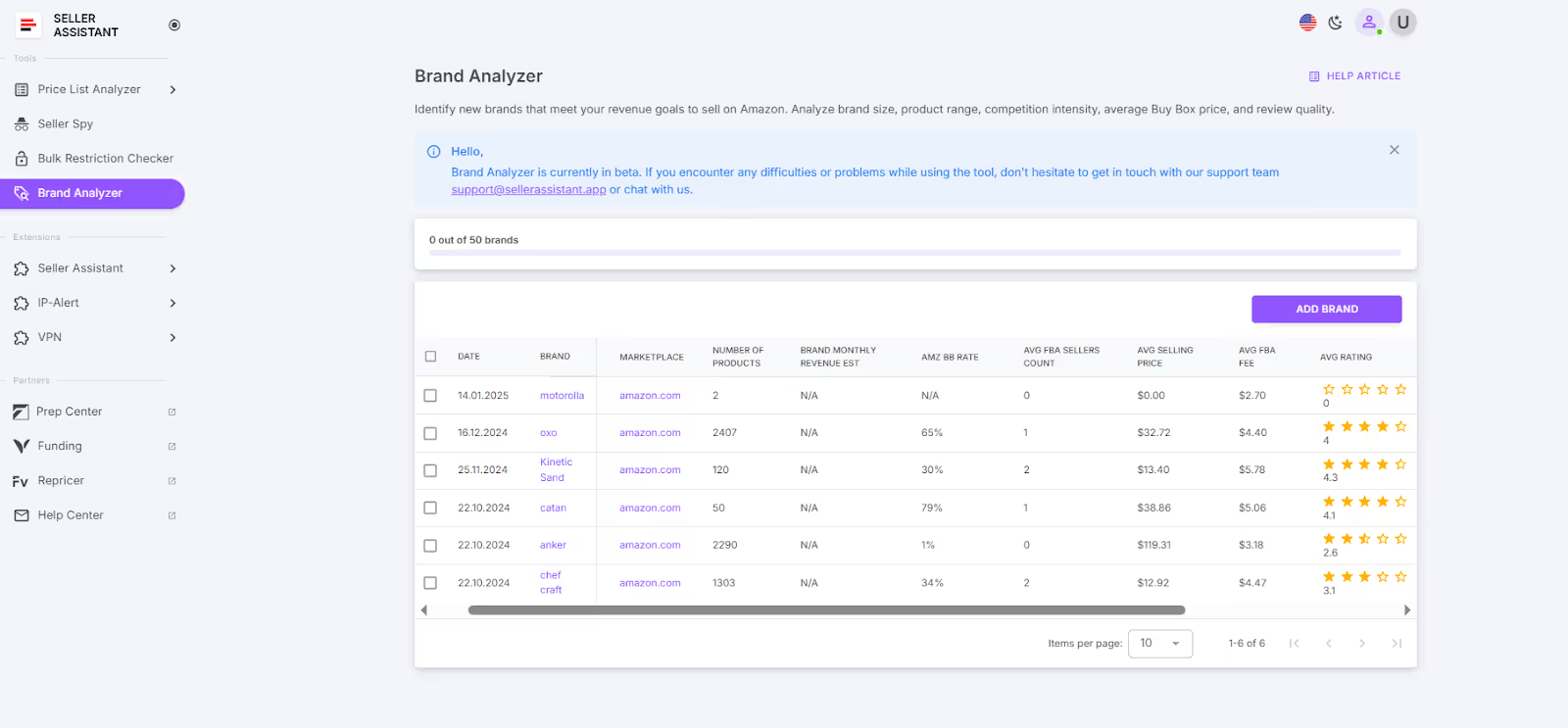
How to research effectively
- Sales performance
Analyze average revenue and sales trends to gauge market demand.
- Competition level
Avoid brands where Amazon holds more than 30% of the sales or where there’s excessive third-party competition.
- Product range
Focus on brands with at least 500+ UPCs for a wider range of profitable options.
- Customer feedback
Prioritize brands with strong customer satisfaction (4+ stars and positive reviews).
- Selling eligibility
Use Bulk Restriction Checker to confirm resale eligibility – green locks mean sellable, red closed locks mean restricted, and red exclamation marks mean the product is blocked for your account.
Who it’s good for
- Wholesale sellers developing brand-focused product portfolios.
- Online arbitrage sellers and dropshippers focusing on high-performing brands.
Method 3. Competitor storefront analysis
What it is
Competitor storefront analysis involves studying other Amazon sellers’ catalogs to discover profitable, proven products already in demand. By analyzing what your competitors are successfully selling, you can shortcut your product research and follow data-backed opportunities.
What it achieves
The aim is to find top-performing products and brands competitors are listing, and then source and sell similar or identical items yourself – reducing guesswork and improving your success rate.
How it works
With Seller Assistant’s Seller Spy, you can monitor competitor stores to see which products they’re selling, recently added, or removed, and how they’re adjusting their pricing strategies. This intelligence allows you to replicate winning products and maintain competitive pricing.
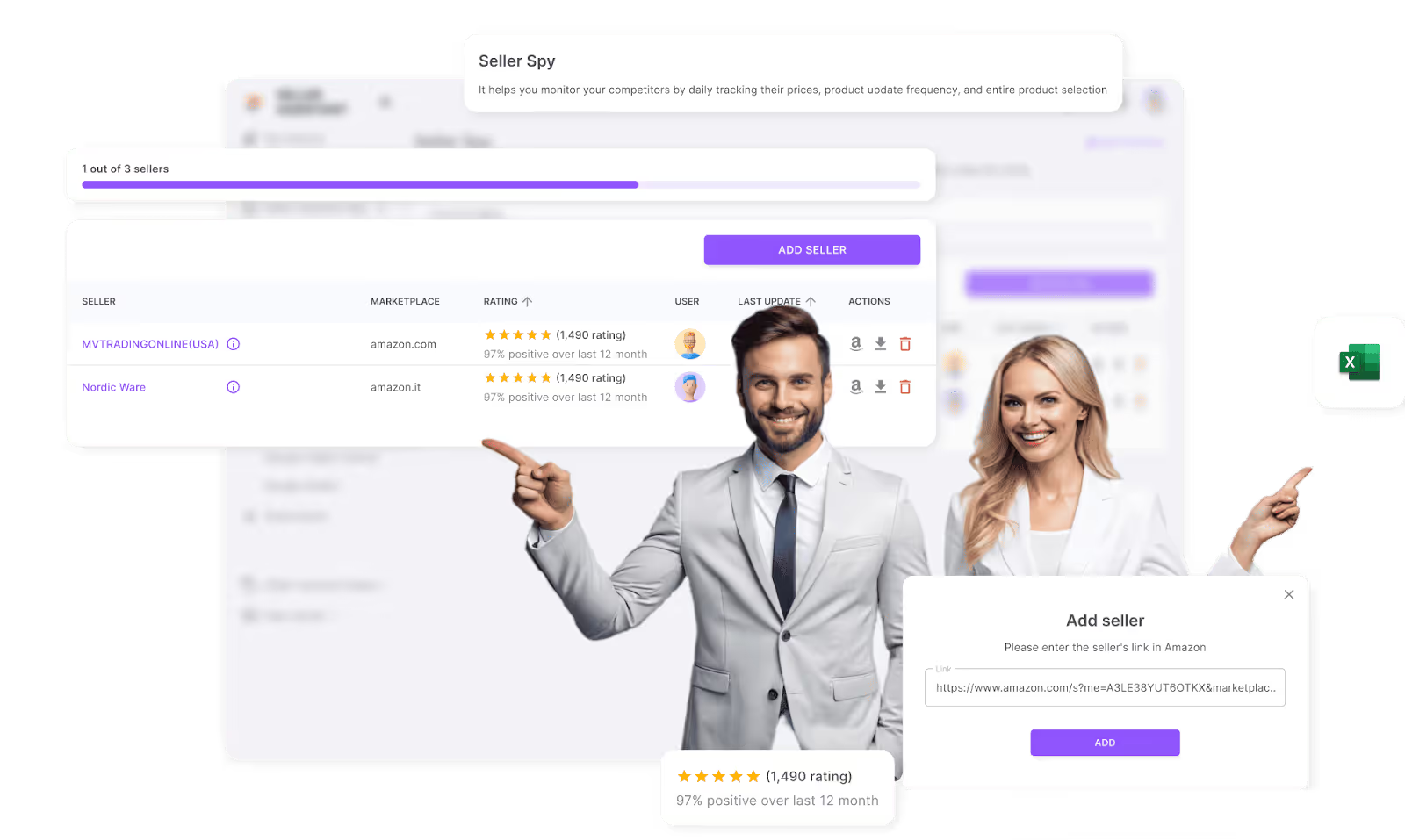
How to research effectively
- New product monitoring
Watch what products competitors are adding to their stores to spot emerging trends early.
- Product removals
Track which products competitors stop selling – these may indicate declining demand or increased risks.
- Seller feedback
Review competitor product ratings and customer reviews to assess customer satisfaction and potential product issues.
- Pricing strategies
Analyze how competitors adjust their pricing to optimize your own Buy Box competitiveness and protect your margins.
Who it’s good for
- Online arbitrage sellers looking for proven, high-demand products.
- Wholesale sellers aiming to expand into successful product lines.
- Dropshippers quickly adapting to new trends and hot products.
Method 4. Manual deep-dive product research
What it is
Manual deep-dive product research focuses on individually analyzing products to evaluate profitability, competition levels, and risk factors. It’s ideal for sellers who want a highly detailed, hands-on approach to product selection.
What it achieves
The goal is to ensure every product you add to your inventory is thoroughly validated for sales potential, Amazon compliance, and profitability – minimizing costly mistakes.
How it works
Using the Seller Assistant Extension, you can access real-time data across Amazon’s search results, product pages, supplier websites, and competitor storefronts. The tool provides insights into sales performance, pricing metrics, competition, and potential risk warnings – allowing for highly informed sourcing decisions.
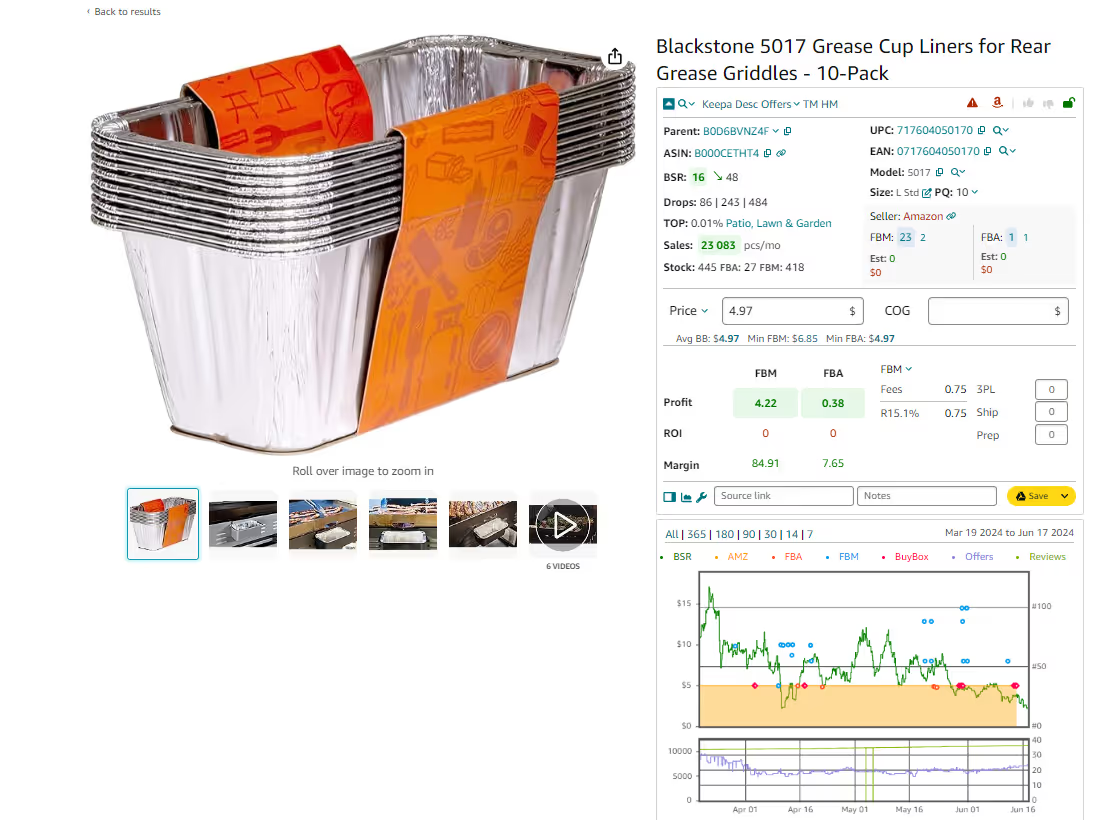
How to research effectively
- Sales performance
Analyze the Best Sellers Rank (BSR) – ideally between 1 and 200,000 – along with long-term sales trends to verify consistent demand.

- Competition analysis
Check the number of FBA and FBM sellers (a range of 2–15 sellers is ideal). Use the Offers feature in Seller Assistant to see stock levels and pricing details.
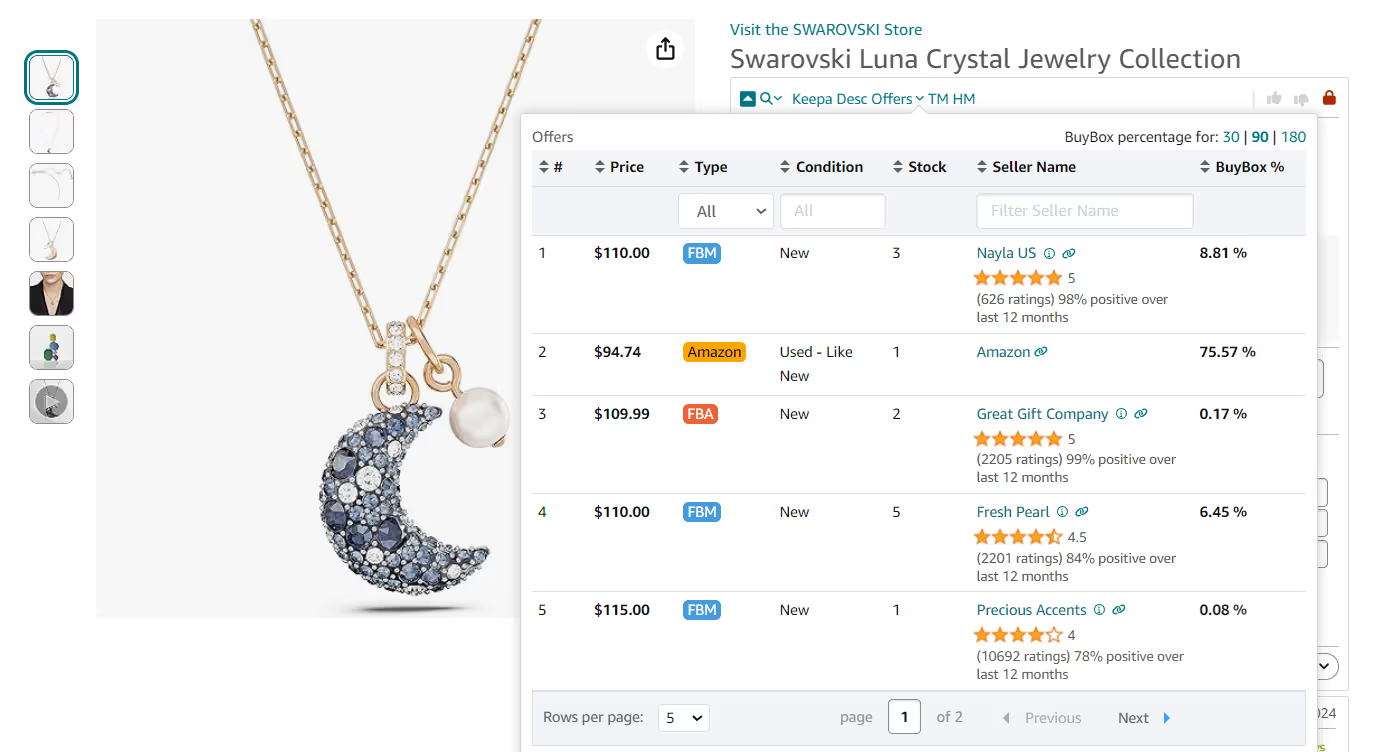
- Amazon in the Buy Box
Identify if Amazon itself sells the product and if it dominates the Buy Box. Competing with Amazon often means losing the Buy Box, so these products are better avoided.

- Profitability metrics
Use Seller Assistant’s built-in FBA&FBM profit calculator to verify ROI, profit margins, and breakeven points.
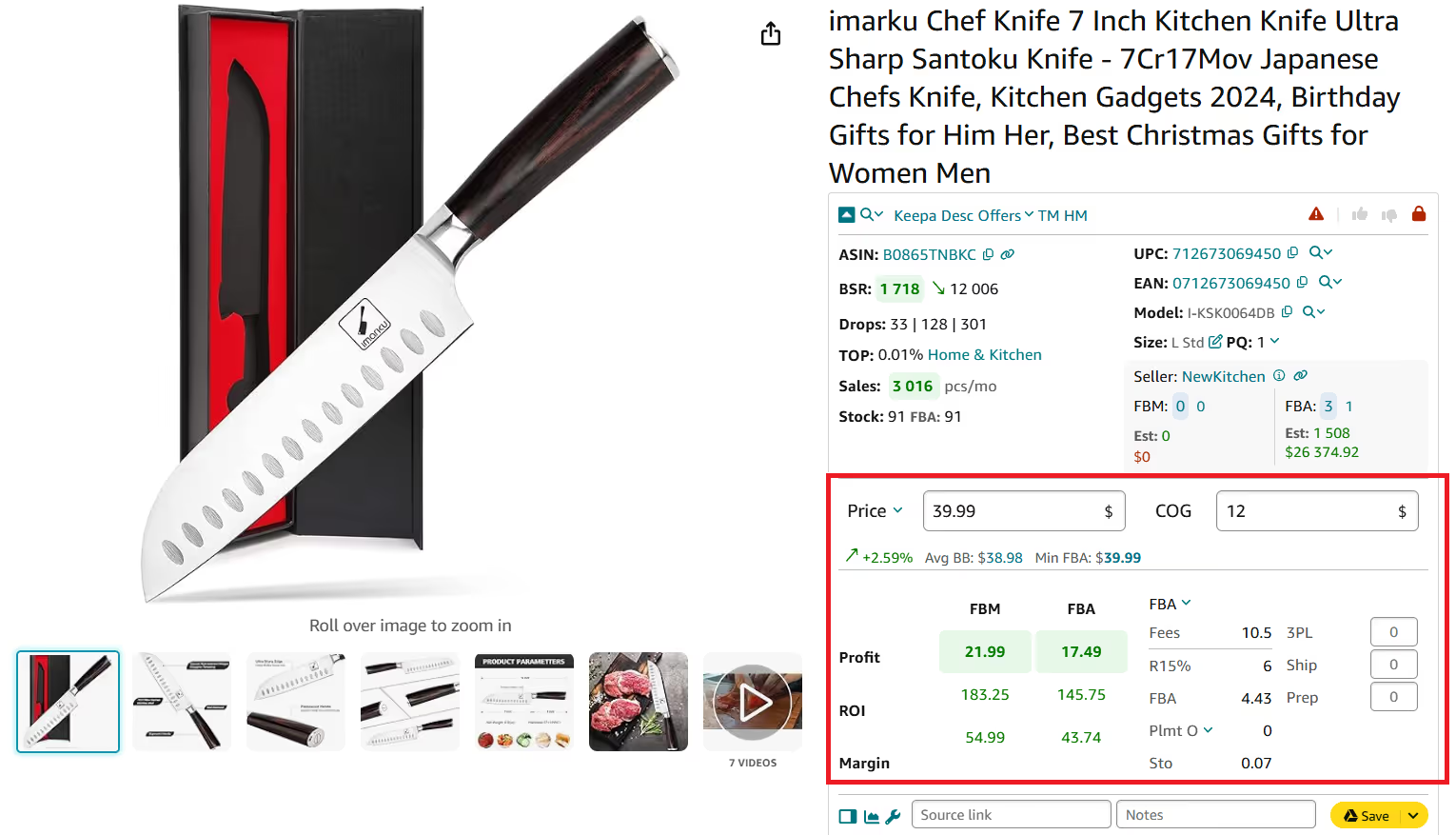
- Risk assessment
Look for risk flags like restricted categories, IP complaints, or problematic product types (fragile, hazmat, heavy and bulky, etc.).
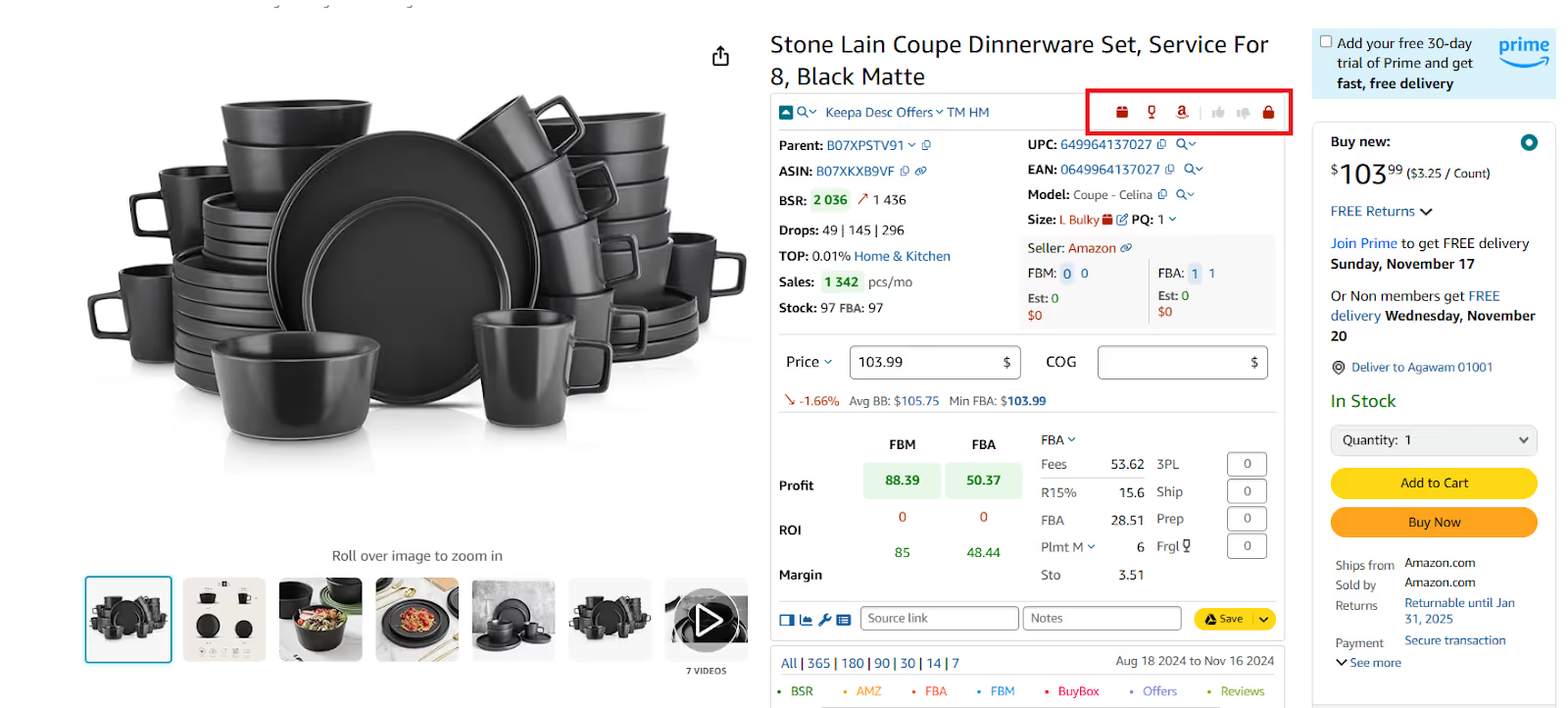
- Historical data
Review integrated Keepa charts to assess long-term sales and price trends. Be cautious of new listings with limited history (at least 6–12 months of data is preferred).

Who it’s good for
- Online arbitrage sellers who require detailed, granular product validation.
- Dropshippers in need of careful, manual verification before listing new products.
- Wholesale sellers manually checking individual supplier deals for accuracy and viability.
FAQ
What is Amazon business model?
Amazon seller business models define how you source and fulfill products on the platform to generate profit. Different models, like private label or arbitrage, offer distinct advantages and risks, and many sellers combine multiple models for optimal reach and profit.
What are Amazon business models?
Popular Amazon business models include private label (creating your own brand), wholesale (buying in bulk and reselling), arbitrage (finding lower-priced products and reselling them), and dropshipping (supplier ships directly to customers). Each offers different pros, cons, and profit margins.
What is Amazon FBA business model?
In the Amazon FBA model, sellers send products to Amazon's warehouses for storage and fulfillment. Amazon picks, packs, ships, and handles customer service for a fee, allowing sellers to focus on sourcing while benefiting from Amazon's logistics expertise and reach.
How to sell on Amazon business models?
There's no single "how-to" for selling on Amazon, as diverse business models exist, each with unique steps. Choose a model like online arbitrage or dropshipping, research its specifics, set up your seller account, source products with Seller Assistant, and manage fulfillment (FBA or self-fulfillment).
How many Amazon business models are there?
There are five main Amazon business models: wholesale, private label, retail arbitrage, online arbitrage, and dropshipping. Each model offers different levels of control, investment requirements, and growth potential.
How long does it take to get started with retail arbitrage?
You can typically start retail arbitrage within a few days to a couple of weeks. Once you create your Amazon seller account and source your first profitable products, you can begin listing and selling almost immediately.
Final Thoughts
In conclusion, finding profitable products for Amazon reselling business models requires a strategic approach, careful research, and the right tools. Whether you're analyzing wholesale price lists, researching brands, tracking competitors, diving deep into individual product analysis, or combining these methods, smart sourcing decisions are the foundation of a successful business.
Using advanced solutions like Seller Assistant dramatically improves your efficiency, reduces risks, and helps you consistently uncover high-margin opportunities.
Seller Assistant is an all-in-one product sourcing software offering all the features vital for product sourcing. It combines three extensions: Seller Assistant Extension, IP Alert, and VPN by Seller Assistant, tools: Price List Analyzer, Brand Analyzer, Seller Spy, Bulk Restrictions Checker, and API integrations, and features: Storefront Widget, Side Panel View, FBM&FBA Profit Calculator, Quick View, ASIN Grabber, UPC/EAN to ASIN converter, Stock Checker, and other features that help quickly find high-profit deals. Seller Assistant also offers integration with Zapier allowing to create custom product sourcing workflows.
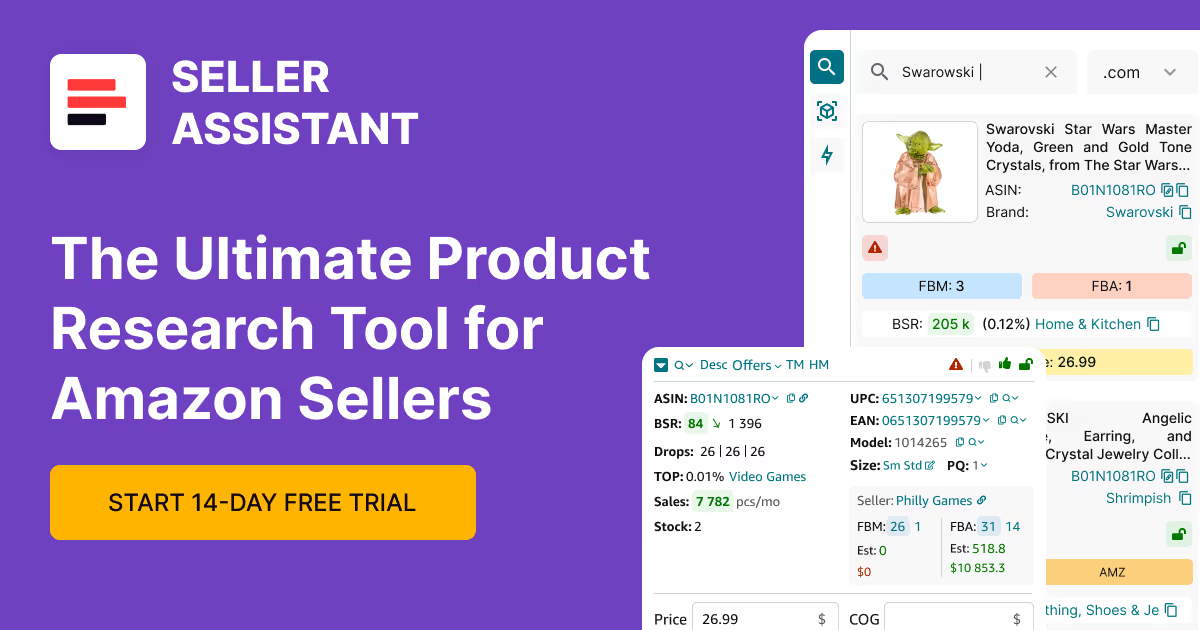
.svg)













